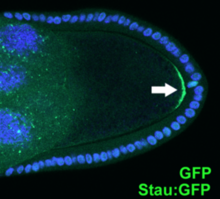Cell polarity refers to spatial differences in shape, structure, and function within a cell. Almost all cell types exhibit some form of polarity, which enables them to carry out specialized functions. Classical examples of polarized cells are described below, including epithelial cells with apical-basal polarity, neurons in which signals propagate in one direction from dendrites to axons, and migrating cells. Furthermore, cell polarity is important during many types of asymmetric cell division to set up functional asymmetries between daughter cells.
Many of the key molecular players implicated in cell polarity are well conserved. For example, in metazoan cells, the PAR-3/PAR-6/aPKC complex plays a fundamental role in cell polarity. While the biochemical details may vary, some of the core principles such as negative and/or positive feedback between different molecules are common and essential to many known polarity systems.[1]

- ^ Altschuler, Steven J.; Angenent, Sigurd B.; Wang, Yanqin; Wu, Lani F. (August 2008). "On the spontaneous emergence of cell polarity". Nature. 454 (7206): 886–889. Bibcode:2008Natur.454..886A. doi:10.1038/nature07119. ISSN 1476-4687. PMC 2562338. PMID 18704086.